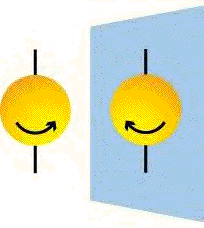How Will These Theories Affect our Lives?
The mirror matter theory, and further discoveries on neutrinos, has, is, and will continue to change the face of science as we know it today, in various ways:
Symmetry in Nature
Most particles in nature are capable of spinning in both a clockwise and counter clockwise manner; however, there are certain particles which only have a left handed spin. This creates an asymmetry in nature; however, if mirror matter were to exist, this asymmetry would be corrected as all particles which are part of the mirror reality would naturally have a spin opposite to that of their counterparts in the realm of ordinary matter.

The asymmetry in nature would be
effectively corrected if mirror matter
were proved to exist.
It was believed sometime ago that, anti-matter, matter with an opposite charge and usually an opposite spin to that of its ordinary matter counterpart, restored the symmetry in nature. This is true for all but one particle, the kaon. In a 1964 experiment, it was observed that anti-kaons do not have the opposite spin of rdinary kaons. Once again the theory of symmetry in nature was destroyed, and further encouraged physicists to believe in this “mirror matter.”
The Dark Matter Theory
The distribution of mass in a galaxy, as well as the approximate mass of it itself, can be determined by working out the velocity of stars at various distances and locations in relation to the galactic core. Based on the calculations of numerous independent astrophysicists, it has been discovered that instead of the orbital velocities of objects in the Milky Way galaxy decreasing as their distances from the centre increases, the velocities appear to remain fairly constant. This information has led scientists to the conclusion that the bulk of the mass in our galaxy, as well as countless other galaxies, is found around the galaxy itself, quite in contrast to the once popular belief of it being situated at the core. This additional mass seems to form an invisible sphere, or halo, around our flat, disc-shaped galaxy, extending far beyond the visible border. These halos are thought to contain several times the mass of the galaxies which they encompass. As a result, scientists now believe that ninety per cent of the universe's mass is “missing” or made up of this mysterious dark matter. Also, astronomers have detected massive planets that orbit extremely close to other stars. Astronomers have been unable to directly observe these planets, they have only detected wobbles in stars and have thus calculated the planets' orbits. These strange planets are also expected to be comprised of dark matter.
There are many candidates for dark matter, including brown dwarfs, small stars which never reach the temperature necessary to burn hydrogen, and white dwarfs, faint dead stars, to name a few. However, it turns out that these proposed possibilities actually create more problems than they solve! One of the more probable candidates for dark matter is mirror matter. Not only does the mirror matter theory does agree with observed data, with regards to the halos found around the galaxies, unlike other candidates, but it also offers insight into how the huge planets that astronomers have detected could be orbiting in such close proximity to their suns. These planets could not be made up of any type of ordinary matter, as they are so close that the friction of rubbing against the star's thin solar atmosphere would cause them to be dragged into the star. However, if these planets were comprised of mirror matter, their gravitational force would cause their stars to wobble, yet these planets would not be affected by the friction.
The Future of the Universe
At present time, the universe is expanding; but this may not always be the case. Actually, there are three different possibilities to the future of our universe:
In order to determine which of the three possibilities above will be the fate of our universe, its average mass density must be calculated:
If the universe's average mass density is below the critical density (approximately 10-26 kg/m3), the universe will have a negative curvature and be open.
If the universe's average mass density is equivalent to the critical density, the universe will have no curvature and be flat.
If the universe's average mass density is above the critical density, the universe will have a positive curvature and be closed.
Currently the actual density of the universe has been calculated to be considerably below the critical density; however, the actual density has only been based on the amount of visible matter in the universe. If dark and/or mirror matter does in fact exist, the actual density would be pushed up to meet the critical density, if not surpass it. Also, the recent discovery that neutrinos, (and mirror neutrinos, if they do exist) have mass could have a substantial impact on the density of the universe. Though infinitely minute, neutrinos are so abundant in nature that this may just be the discovery we've been weighting for!
Dreaming Of A Mirror Universe | What is Mirror Matter? | What are Neutrinos? | The Solar and Atmospheric Neutrino Anomalies | Nature's Four Forces | The Detection of Mirror Matter | How Will These Theories Affect our Lives? | Did You Know...? | Conclusion | Bibliography | Acknowledgements | Related Links